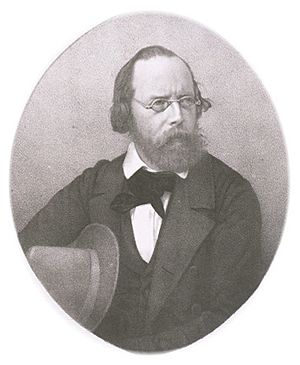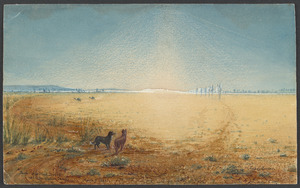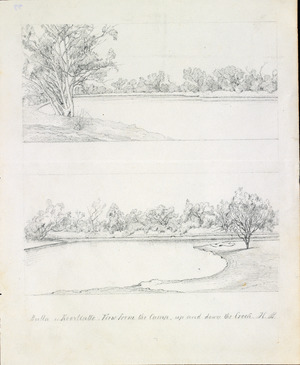Dr Ludwig Becker's Grave facts for kids
Quick facts for kids Dr Ludwig Becker's Grave |
|
|---|---|
| Lua error in Module:Location_map at line 420: attempt to index field 'wikibase' (a nil value). | |
| Location | Molesworth Station, by the Bulloo River, Bullo Downs, Shire of Bulloo, Queensland, Australia |
| Design period | 1840s - 1860s (mid-19th century) |
| Built | April 1861 |
| Official name: Dr Ludwig Becker's Grave | |
| Type | state heritage (built) |
| Designated | 5 August 1994 |
| Reference no. | 601359 |
| Significant period | 1860s (historical, fabric) 1860s- (social) |
| Significant components | burial/grave, grave surrounds/railings, plaque |
Dr Ludwig Becker's Grave is a special heritage site in Queensland, Australia. It is located at Molesworth Station, near the Bulloo River. This grave belongs to Dr. Ludwig Becker, who was an important member of the famous Burke and Wills expedition. He was buried here in April 1861. This site is protected and listed on the Queensland Heritage Register because of its historical importance.
Contents
Who Was Ludwig Becker?
Ludwig Becker was born in Germany in 1808. He earned a PhD degree. He left Germany in 1848 due to political reasons. After living in Brazil for a while, he moved to Launceston, Tasmania in 1851.
People described Becker as a very talented person. He was a great naturalist and geologist. He could also draw, play music, sing, and even imitate bird sounds!
In the early 1850s, Becker worked as a gold miner in Bendigo, Victoria. While there, he studied the weather and created many sketches. He showed his art in Melbourne in 1854. He became a key member of important scientific and art groups in Victoria. He also studied the lyrebird, a unique Australian bird. He even tried to raise a lyrebird chick.
Becker's scientific knowledge and artistic skills made him perfect for exploring. He was chosen to join the Burke and Wills expedition in 1860. This expedition was a big event for science in Australia.
The Burke and Wills Expedition
The Burke and Wills expedition was a major journey across Australia. It was led by Robert O'Hara Burke, a police superintendent. The goal was to be the first to cross the continent from south to north. This was a race against another explorer from South Australia.
This expedition was very expensive, costing over £60,000. Many people and animals were part of it. The team had camels, horses, wagons, and enough food for two years. The main members included Burke, William John Wills (surveyor), and two German scientists: Ludwig Becker (artist, naturalist) and Herman Beckler (doctor, botanist).
Setting Out on the Journey
The expedition started from Melbourne on 20 August 1860. They traveled through settled areas to Menindee by early October. Burke was in a hurry and left many supplies behind.
Becker's job was to collect specimens and keep a daily diary. He also had to draw maps and illustrations. He sent his first reports from Swan Hill and Menindee. But he felt sad when his work was not acknowledged.
Burke became impatient with the scientific work. He ordered Becker and Beckler to stop their studies. He wanted them to work like everyone else and walk instead of ride. Becker sometimes went without food for three days. He had to do his writing and sketching at night.
Challenges and Illness
The expedition faced many problems. Burke made some poor decisions, like dividing his group. He rushed ahead to Cooper's Creek. He told William Wright to follow with supplies. But Wright waited in Menindee for three months.
Becker was with Wright's group in Menindee. He was frustrated by the delays. He stopped writing daily reports and focused on sketching. He knew the expedition might fail. His letter to the committee about the delays was ignored.
Wright's group finally moved north in January 1861. By February, Becker and others were very sick. They suffered from scurvy and bad water. Becker and William Purcell, the cook, became very ill. Wright tried to reach Cooper's Creek but turned back. Beckler stayed with the sick men. He wrote that Becker was unlikely to recover.
Becker's Final Days
Wright's party reached Bulloo on 21 April. They never made it to Cooper's Creek. Meanwhile, Burke's main party had reached the Gulf of Carpentaria and returned. They arrived back at Cooper's Creek on 21 April 1861. They were tired, hungry, and in rags. They found their camp empty. The support party had left that same day.
The support party arrived at Wright's camp at Bulloo on 28 April. Dr. Ludwig Becker was mostly unconscious by this time. He sadly passed away on 29 April 1861. He was buried near William Purcell and Charles Stone, who had died a few days earlier. Dr. Beckler said that Becker died from dysentery and exhaustion. After his burial, Becker's belongings were burned or packed to be sent to Melbourne.
Burke, Wills, and King tried to reach Mount Hopeless. But they were too weak. Only King survived, living with Aboriginal people. He was later rescued by a search party.
Why Is This Grave Important?
A special investigation looked into the deaths of Burke and Wills. It found that Burke made mistakes. He divided his party and trusted Wright too much. He also left Cooper's Creek too early.
Even with the expedition's problems, Becker's work was important. He made daily weather observations until he died. Newspapers and journals in Australia and Germany mourned his death. His colleagues at the Royal Society missed him greatly.
The Governor of Victoria, Sir Henry Barkly, praised Becker. He said Becker's name would be remembered with other brave explorers. The City of Ballarat built a clock tower in 1863 to remember the explorers. A small area in Queensland is named Becker to honor him.
Becker's grave is a memorial to his life. It also reminds us of the Burke and Wills Expedition. His grave shows how important he was to Australian history.
What Does the Grave Look Like?
Dr. Ludwig Becker's grave is located on a stock route. It is on the western bank of Kooliatto Waterhole. This is near Molesworth Station, southwest of Thargomindah.
The gravesite has a plinth (a stone base) with a plaque. There are also three timber posts. A low metal fence surrounds the grave.
Heritage Listing
Dr Ludwig Becker's Grave was added to the Queensland Heritage Register on 5 August 1994. It meets important criteria for historical places.
The place shows how Queensland's history developed. Dr. Ludwig Becker was an artist, explorer, and naturalist. He is seen as a "martyr to science." He was a key part of one of Australia's most famous expeditions.
The place is linked to an important person or group in Queensland's history. His grave and its location remember his life. They also honor the entire Burke and Wills Expedition.




